We’ve all seen or experienced high-level fluffy vision and mission statements by well-intentioned senior leaders designed to inspire and motivate the workforce towards a common value-driven future.
Some typical “high-level fluffy” corporate visions.
Our mission is focused on 6 core aspirations the company continually strives to achieve.
... to help make every brand more inspiring and the world more intelligent.
Our worldwide operations are aligned around a global strategy called the "Plan to Win," which centers on...
However, these mission statements tend to be generic, broad, and completely detached from the day-to-day project team perspective. What’s more, they say nothing about the role innovation will play in making sure you get there.
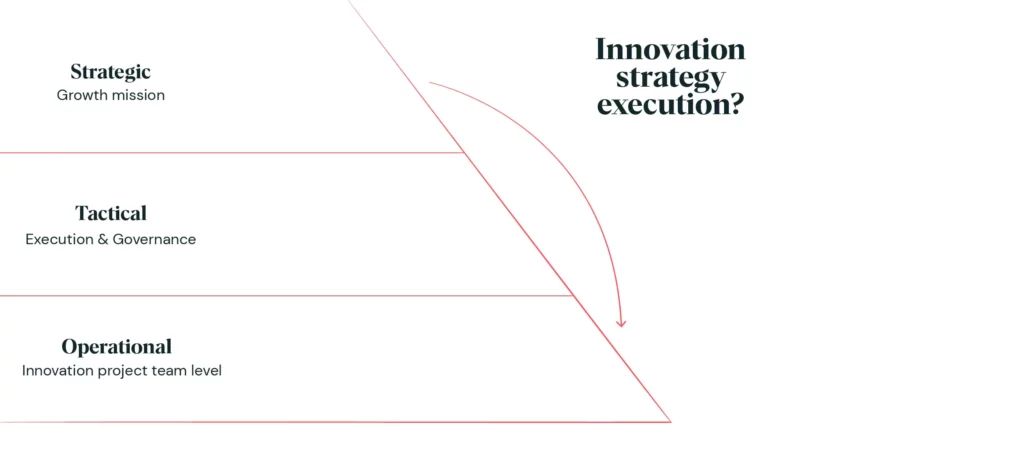
This creates a distinct gap between your strategic business growth mission and your operational project teams, leading to confusion.
When this happens, initiatives that do get a little bit of funding to ‘do some innovation’ are typically fragmented and isolated as pockets of short-lived enthusiasm. They tend to head off in all sorts of directions across global business units, which makes managing innovation centrally, whilst tracking impact metrics and accountability, rather tricky, to say the least.
Further to this, after the fancy pitching event has ended, workshop fatigue, Post-It blues, and Sharpie-fume headaches quickly set in and momentum and effort die when the team’s perfectly validated concepts and business models hit the concrete wall that is trying to get buy-in from middle managers to push the projects forward. These profiles simply can’t take on radical and disruptive growth engines because they’re bound to and by the perpetual treadmills that are short-term quarterly reviews. Many strategic innovation initiatives require ‘slow money,’ and that just doesn’t fit the existing business logic (not yet, at least).
Innovation programs – such as one-off Design Thinking trainings, design sprints, internal innovation competitions (and other formats) – seem like a great idea at the time. But if they’re not accountable to deliver actual business impact outcomes as return on innovation (ROI), funding quickly dries up and is instead allocated to initiatives like shiny new Agile capabilities and smart open-plan working spaces to go with them.
You have an amazing, albeit short-lived, push towards true business impact innovation that ultimately ends up being nothing more than a wonderful innovation-theatre production that leaves people scratching their heads wondering: why did this not work out as we intended at kick-off?
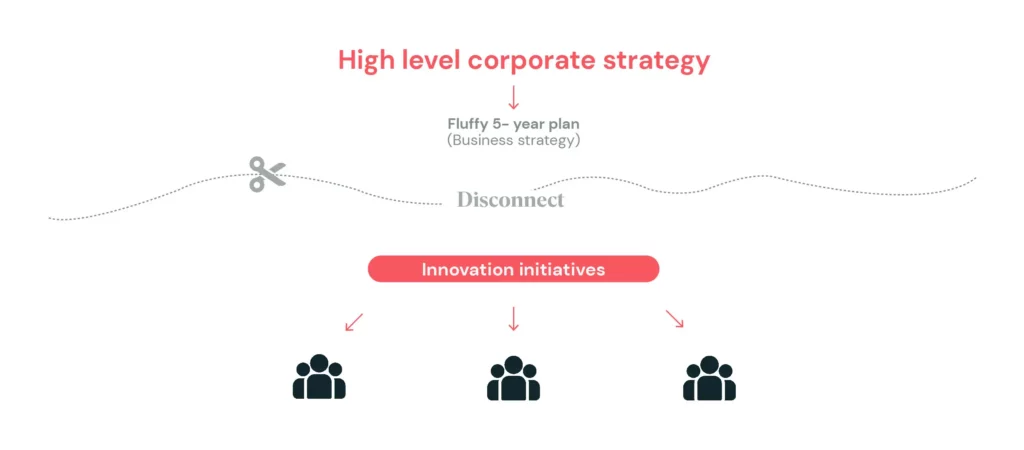
Skepticism and frustration soon follow. If there was little (if any) disconnect between the corporate vision, business strategy, and the boots on the ground from the outset, why didn’t results materialize?
The good news is that that it doesn’t have to be like this! Quite the opposite.
3 crucial questions innovation strategy must answer
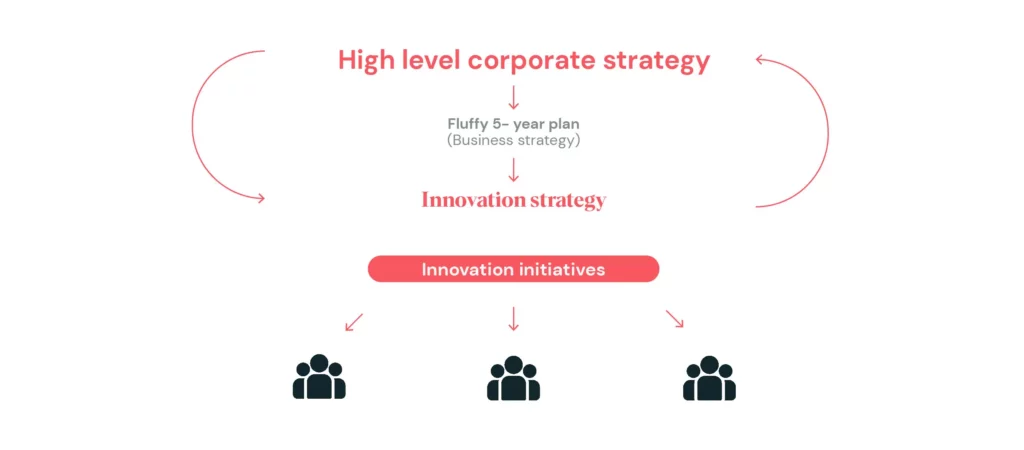
To achieve results, 3 crucial elements of your innovation strategy must be aligned right from the top, down to the project team at the operational level. This is done by answering 3 simple questions that intimately tie together the role of corporate-level business strategy and innovation activities:
- Where are you now?
- Where do you want to go?
- How are you going to get there?
Answering these questions is what your innovation strategy will enable. Doing so will produce an interlinked way of working from the bottom to the top and vice versa. This approach is designed to deliver business impact where and when it is expected.
Put simply, your innovation strategy provides the missing link between your project teams and the desired business outcomes. It’s your fluffy vision made liveable, actionable, and deliverable.
It’s your fluffy vision made liveable, actionable, and deliverable.
Does that sound too good to be true? Then read on…
To answer the 3 crucial questions above, your actionable innovation strategy will produce the following 6 key components and deliverables:
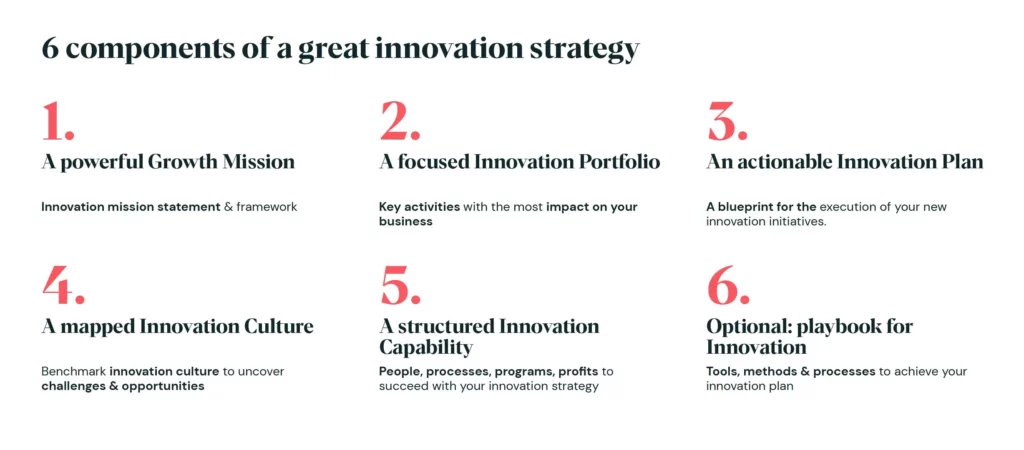
- Innovation Culture: understanding what you’re good at and what needs building upon further to achieve the desired business outcomes
- Growth Mission: a clearly defined trajectory that states where you are going and why, closely tied to your corporate vision and business strategy
- Innovation Portfolio: the key innovation activities you will execute with the most business impact potential
- Innovation Plan: all the specifics to enable the execution of each of your innovation initiatives
- Innovation Capability: the right people, repeatable processes, programs, and profits to succeed with innovation
- Innovation Playbook: the right tools, methods, and processes to do the job of achieving your innovation plan
How to set up your innovation strategy
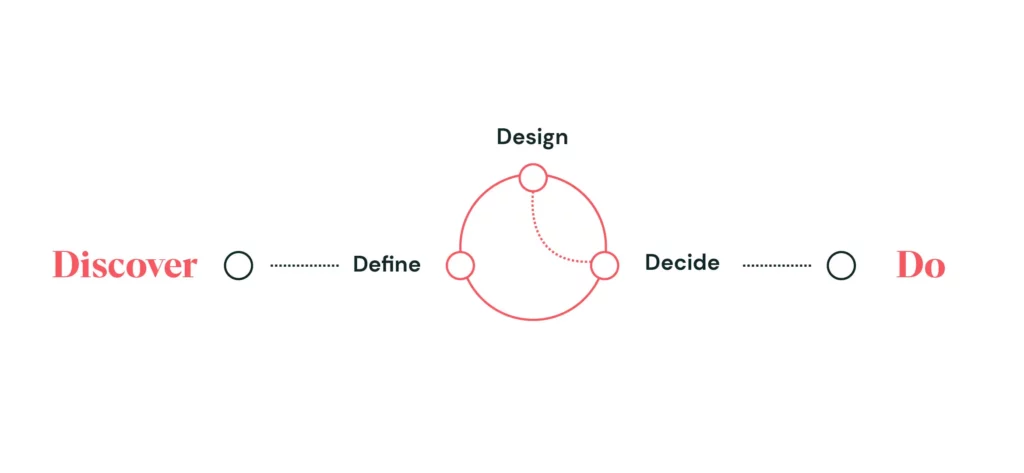
This is where our innovation strategy sprint comes in. A fast-paced format designed to span 5 days, it enables your organization to make decisions quickly. The sprint will answer your 3 crucial questions (where are you now, where do you want to go, and how are you going to get there?) whilst bridging the gap between operational teams and strategic business vision through concrete and specific innovation initiatives and capabilities.
Who’s involved: Core team and executive team
You will need to establish a core working team of around 6 cross-disciplinary people. Your executive team, including C-levels and senior leaders, will be requested to schedule 30-minute blocks of time at several key moments where and when needed throughout the week-long sprint.
The innovation strategy sprint day-by-day
Discover
Day 1: Why
On Monday, you carry out exploratory research inside and outside your industry to uncover signals of disruption and new opportunities for growth.
You’ll present the results from your innovation audit (carried out prior to the sprint) from both qualitative and quantitative research methods to triangulate the major pain points blocking your current innovation initiatives and capabilities.
Key results
- Get an overview of key market trends and drivers
- Map out your existing innovation capabilities and activities
- Discover your innovation archetype
- Identify future areas for change
- Answers to crucial question no. 1: Where are you now?
Define
Day 2: Why
On Tuesday, you will inspire your key C-level stakeholders with innovation success cases whilst presenting the outcomes of your innovation audit and macro-environmental opportunity search. You will finish the day by creating your innovation mission statement to fully-align the role of innovation within the corporate- and business-level strategies.
Key results
- Portfolio mapping of relevant innovation initiative types
- A draft list of key activities to support future business growth areas
- Answers to crucial question no. 2: Where do you want to go?
Design
Day 3: How
On Wednesday, you’ll design your first draft initiatives on our innovation blueprint tool and set clear expected goals and impact metrics per innovation activity. You’ll have a clear understanding of the scope, people, and resources needed, along with concrete next steps. You’ll present an early draft to the C-level team to inspire them and receive critical feedback to iterate upon.
Key results
- Map of future initiatives in detail
- Organizational governance model designed
- Innovation accounting, impact metrics, and KPIs defined
- Gain critical feedback and buy-in from the senior management team
- Clear overview of the exact resources needed
Decide
Day 4: What
On Thursday, you’ll further refine your innovation blueprints based upon critical reflective C-level and senior executive feedback from the previous day.
Key results
- A validated action plan for the innovation strategy execution
- A clear go/no-go decision on the implementation of specific initiatives that enable the business strategy and corporate vision
- C-level buy-in and support for the overall strategy and specific innovation activities.
Innovation strategy sprint output example
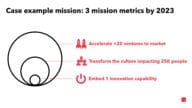
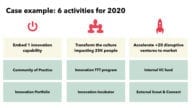
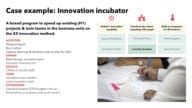
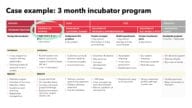
Here is a quick case study to show you some of the output details you can expect. You’ll find an example of a roadmap developed via an innovation strategy sprint that includes an innovation mission, metrics, and 6 defined innovation programs that align with the corporate strategy down to the operational team level (as well as a detailed plan for a 5-month innovation accelerator).
Managing innovation doesn’t need to be a huge, burdensome pain in the b*** that ends up demotivating your best people.
Do
Day 5: What
On Friday, you will plan the kick-off for your concrete innovation initiatives and start nominating or selecting operational project teams. You’ll be able to monitor the business impact results and progress of each initiative with innovation accounting and KPIs, allowing you to make informed pivot or kill decisions. Program pilots can now be organized and run in order to evaluate and adapt as needed in the future.
Key results
- Innovation initiatives ready to get up and running
- Governance model functioning and in place to support initiatives
- Innovation activities and their contribution to the business measured and accountable
Summary
Managing innovation doesn’t need to be a huge, burdensome pain in the b*** that ends up demotivating your best people. You can avoid headaches in the long run by applying sufficient time, energy, and resources before embarking on your innovation journey. To do so, you’ll need to fully align on where you’re at and where you want to go, and clearly define how you’re going to get there.
Innovation is an engaging and highly rewarding way to work. It can effectively de-risk the high degrees of uncertainty and ambiguity that come with pursuing radical and disruptive ideas and bring entirely new and repeatable growth to your organization. At the same time it should be a fun journey (see our program photos and Instagram feed for inspiration). So make sure you set yourself up correctly for success and impact, by laying the right strategic foundations first.
My sentiments are best summarized by this wonderful cartoon I recently found.


